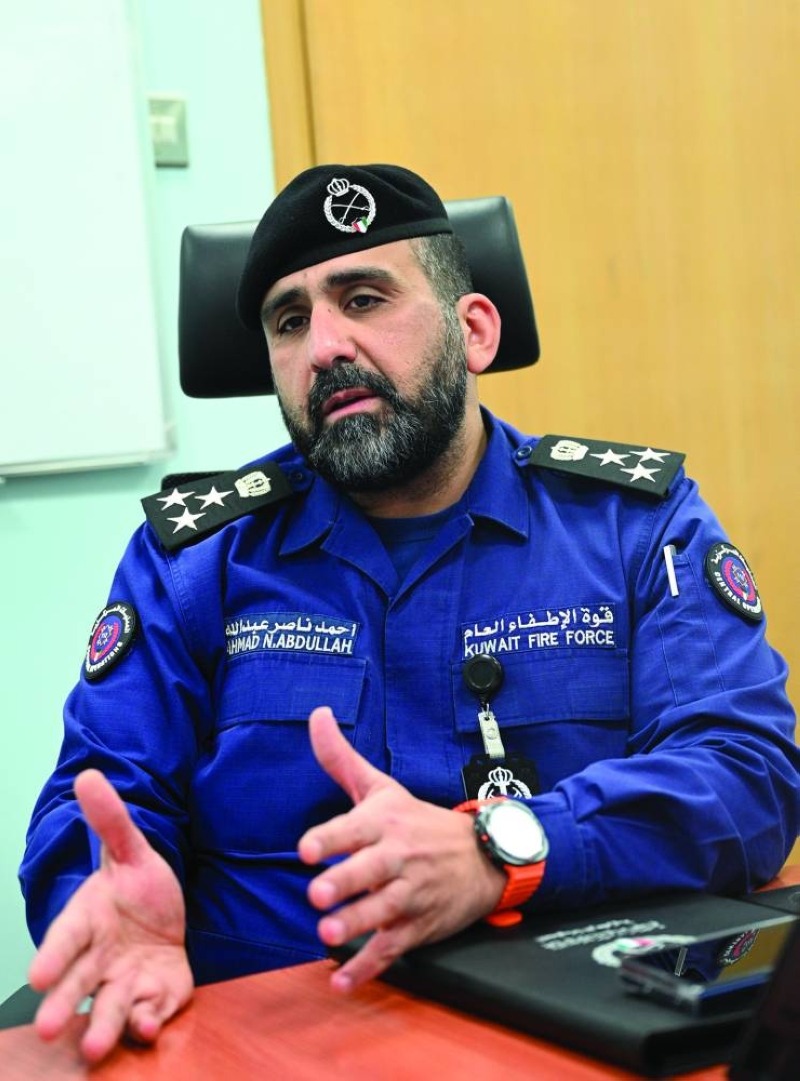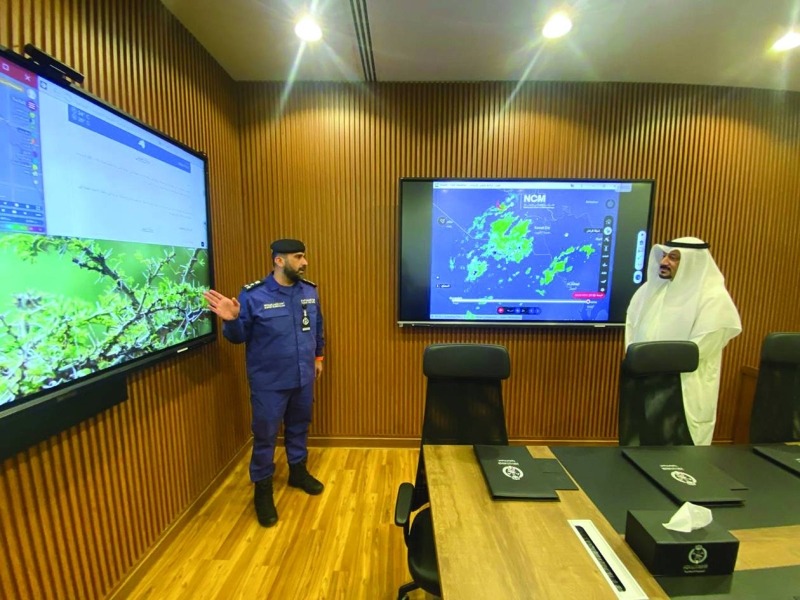Kuwait’s Fire Force’s reserve room to ensure continuous service during emergencies
Brigadier General Ahmed Nasser Abdullah, Director of the Central Operations Department, highlighted ongoing work on an early warning system for government, investment, and commercial buildings to ensure quick detection and response during emergencies.

• Brigadier General Ahmed Nasser Abdullah stated that the Central Operations Department of the Kuwait Fire Force received approximately 13,000 reports from January 2024 till the end of October.
• The Central Operations Department of the Kuwait Fire Force uses advanced computers directly linked to the operations of the Ministry of Interior and is connected to all 43 fire stations in Kuwait to ensure reports are transferred quickly and easily.
• The Kuwait Fire Force is studying the establishment of a dedicated reserve operations room at the Kairouan Center, which will open soon, as well as the creation of a mobile operations room to ensure reports are received even in the most challenging circumstances.
Every day, the red firefighting vehicles weave through traffic, their sirens blaring and lights flashing as they rush to respond to fires, traffic accidents, or other emergencies, according to Al Rai newspaper.
Once drivers see a fire truck behind them, they move aside to make room for it to carry out its task as quickly as possible, without considering how the report reaches the drivers or who is riding with them, or how the task is carried out.
The timely reception and handling of reports is crucial for the success of the mission. Al-Rai newspaper observed that the process should begin with the department responsible for receiving reports—specifically, the operations center of the Central Operations Department of the Kuwait Fire Force. We visited the center to learn about its operations.
The newspaper spoke with Brigadier General Ahmed Nasser Abdullah, Director of the Central Operations Department, who confirmed that the Operations and Control Department receives reports from the public through the 112 emergency hotline. These reports are then forwarded to the relevant fire stations, which are dispatched with the necessary equipment to the scene of the incident.

“After the center arrives at the accident site, whether it is a fire or rescue incident, the operations center receives information from the fire station handling the accident in order to take appropriate actions, such as sending additional units or ambulances through emergency medical operations, or addressing other needs depending on the type and scale of the incident,” he added.
He explained that “the department records all information related to the accident in the Kuwait Fire Force database, which includes accident details, statistics, response methods, names of the injured, and those overseeing the incident.”
He also stated that “the number of reports received by the Central Operations Department of the Kuwait Fire Force from the beginning of 2024 up until the end of October has reached approximately 13,000 reports.”
Early warning system for buildings
Regarding future projects for central operations, the director emphasized that “work is underway to implement an early warning system for buildings, starting with government buildings and followed by investment and commercial buildings, to ensure early detection and reporting, as well as quick response in case of emergencies.
He added that the department is also studying the possibility of directing reports directly through the location, so that the report is recorded in the operating room’s computer system and displayed on the screens of all fire units responsible for the report. This will ensure faster arrival and accuracy of the intended address, in addition to managing the newly installed cameras for live transmission, which will allow us to provide necessary instructions directly from the scene.”

He pointed out that “all of this development is being carried out according to a well-defined plan, which includes the renewal of all existing devices, as well as increasing the capacity and number of phones. The service was also extended to two small cars, which act as operations rooms for use in narrow and residential areas such as commercial complexes, Al-Mubarakiya market, and others, along with two larger vehicles for managing major accidents. He stressed that ‘the Kuwait Fire Force places great importance on the development of operations because it is the foundation for the work of the centers. Operations rely on having accurate information available for the centers.'”
Global database for hazardous materials and chemicals
Brigadier General Ahmed said, “The Operations and Control Center has a database containing global programs for hazardous materials and chemicals found worldwide, along with programs specialized in weather and earthquake monitoring to predict natural disasters and enable a swift response.
The department also uses advanced computers directly linked to the operations of the Ministry of Interior and is connected to all 43 fire stations in Kuwait, both land and sea centers, to ensure reports are transferred quickly and easily.
Additionally, the center uses a special program that provides the exact address for incidents based on the civil number of each building in Kuwait, in cooperation with the General Authority for Civil Information. This program is particularly useful in remote and unclear locations.”
He stated, “The operations room receives many false reports; most of which are made by children. However, we take every report seriously and verify its source. The operations center maintains data on disabled individuals and their addresses, so if an accident is reported at a residence with a disabled person, this information is confirmed and the fire center responsible for the area is notified to ensure a quick response. This data is gathered in cooperation with the General Authority for Disability Affairs.”
He added, “The Kuwait Fire Force is studying the establishment of a dedicated reserve operations room at the Kairouan Center, which will open soon, as well as the creation of a mobile operations room to ensure reports are received even in the most challenging circumstances.”
‘Decision-making’ room in central operations
Brigadier General Ahmed pointed out the existence of a “decision-making” room in central operations, explaining that it “contains a special screen that transmits accidents directly to the operations center. This screen allows us to detect deficiencies and give direct orders as an operations officer for decision-makers present at the scene.
Additionally, the major operations vehicle, used in large-scale incidents like fires or industrial accidents, is equipped with an operations center for leaders at all levels. It includes a display screen to track the fire’s spread and cameras that rise to more than 15 meters to capture images of the area, which are transmitted directly to the room of the head of the force.
He added, “The operations center has a plan to deal with major disasters, coordinated with other authorities such as the Ministry of Interior, Medical Emergencies, Works, and Municipality. This coordination is part of the annual (commemorative) exercise held under the auspices of the Kuwait Fire Force to ensure each party’s readiness and the tasks assigned to them.”
He revealed that “the Kuwait Fire Force is studying the establishment of a fully equipped reserve operations room at the Kairouan Center, which will open soon. Additionally, a mobile operations room is being developed to ensure reports are received even under the most difficult circumstances. A special building for fire operations is also being designed within the fire complex to be constructed in the Sulaibiya area, incorporating the latest technology.”
Incorporating female staff in the operations
Brigadier General Ahmed Nasser stated that “one of the goals of the development plan for operations is to explore the possibility of incorporating female staff, particularly after studies have shown that women have proven their value in delivering and receiving information. Evidence of their success can be seen in the Ministry of Interior’s Operations Room.”
Hiring staff for direct video communication with deaf and mute
Brigadier Nasser pointed out that “there is a possibility of employing individuals who can communicate with the deaf and mute through direct video communication to relay information.”
He added that “there is also training to activate the role of the communication director (the recipient of the message) in internal processes, helping them understand how to add value to the message and effectively deliver information to the center.”
Efforts to hire multilingual staff in Kuwait’s Fire operation
Brigadier Ahmed Nasser explained that “one of the ongoing projects is to employ individuals who are proficient in foreign languages, especially since there are around 130 nationalities in Kuwait. We need people skilled in foreign languages to assist in communication. Additionally, self-translation devices are being introduced to help foreigners submit their reports. These devices provide automatic responses in the caller’s chosen language, using artificial intelligence programs.”

12-hour shifts and 48-hour rest period
Brigadier Ahmed Nasser emphasized that “the work system in the Central Operations Department, like in various fire stations, follows a four-shift system: one shift consists of 12 working hours, followed by 48 hours of rest. All employees in the Central Operations Department, who handle reports from specialists in operations management, undergo specialized communication courses to learn how to effectively receive and manage reports. They also receive training as firefighters.”













